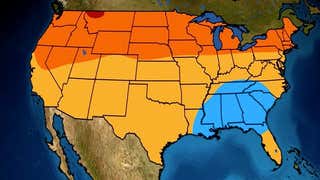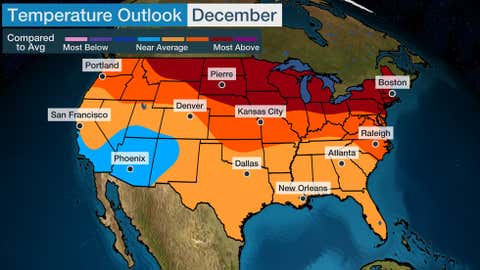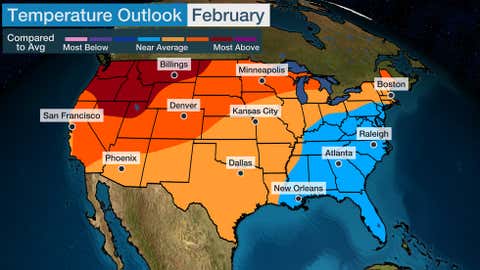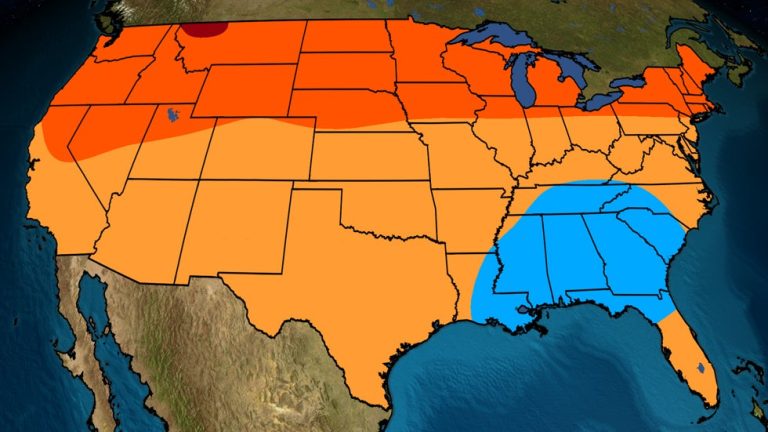

- The El Niño phenomenon is expected to play a role in affecting winter temperatures.
- This typically means milder winters in the northern United States, and cooler and wetter conditions in parts of the south.
- But there are some important factors that can change the winter forecast.
Temperatures this winter in the United States could be an El Niño effect, according to a forecast published Saturday by The Weather Company, an IBM Business, and Atmopheric G2.
The influence of El Niño is visible in the three-month overall winter forecast: A strong El Niño is likely this winter, which is typically associated with warmer-than-average conditions across much of the northern United States, and also means that parts of the southern United States typically see somewhat lower-than-average temperatures in the winter.
This temperature pattern is generally the subject of the forecast for this winter in the map below.
(More: NOAA's October El Niño update)


The temperature pattern that is expected to dominate the entire three-month period from December through February.
Keep in mind that this forecast is a general three-month trend. Therefore, we are likely to see warmer or cooler periods in each region of the country than shown above.
With that in mind, let's dive into the monthly details and track some important factors that could change this forecast.
Winter can start off warmer than average from the northern Plains to the Great Lakes and Northeast: Those in the northern United States who want cool December weather to set the mood for the holiday season may be out of luck this year. Cities like Minneapolis, Chicago, Boston, and New York City are currently favored to have above-average temperatures.
The southern part of the United States should see temperatures very close to normal.


Temperature forecast for December.
It's possible the southern US will be somewhat cooler than average to start the new year: The hallmark of El Niño is wet, cold conditions in parts of the southern states in the heart of winter, and that's what forecasts show from the southern Plains to Georgia and the Carolinas. It's not a guarantee, but this combination of ingredients could increase the chances of snow and ice in parts of this area.
Parts of the Northwest and Northeast have the highest odds of above-average temperatures in January.


Temperature forecast for January.
The last full month of winter can be characterized by a colder east and warmer west division: In February, warmer than average temperatures can be centered in the northwest and northern Rockies.
The best chance for cooler than average temperatures may be from the Southeast to the mid-Atlantic.


Temperature forecast for February.
These factors can change the winter forecast
1. How large is the atmospheric response to warm El Niño waters in the Pacific Ocean? This atmospheric response in the tropical Pacific, so far, has been muted at this time of year when compared to other historically strong El Niño winters, according to Dr. Todd Crawford, deputy chief meteorologist at Atmospheric G2.
Weather conditions now resemble the 2009-2010 El Niño, which was noticeably colder in the central and eastern U.S., so trends will be monitored in the coming weeks and months to see how El Niño impacts weather patterns this winter. So, whether the outlook might turn cold for some remains to be seen.
2. Will the polar vortex weaken later in the winter? As the polar vortex weakens, cold air normally confined to the Arctic can spread to parts of Canada, the United States, Asia and Europe as the jet stream becomes more obstructed with sharp southward switchbacks, sending more persistent cold air south toward the mid-Arctic. -latitudes.
Crawford said there's a very good chance the polar vortex will weaken in the middle of winter, which means there's a risk of colder temperatures in the U.S. during the back half of the winter.


An example of a weak polar vortex in winter.
3. Does the recent rise in global temperatures affect the size of warmer and colder periods? The Earth was on track to have its warmest year on record as of the end of September.
“The additional burst of global warmth seen in 2023 will lead to an upward compensation of temperatures, meaning warm periods will be warmer than normal and cold periods will be cooler than normal,” Crawford said.
Chris Dolce He has been a senior meteorologist at Weather.com for over 10 years after starting his career with The Weather Channel in the early 2000s.
The Weather Company's primary journalistic mission is to report on breaking weather news, the environment, and the importance of science in our lives. This story does not necessarily represent the position of our parent company, IBM.

